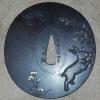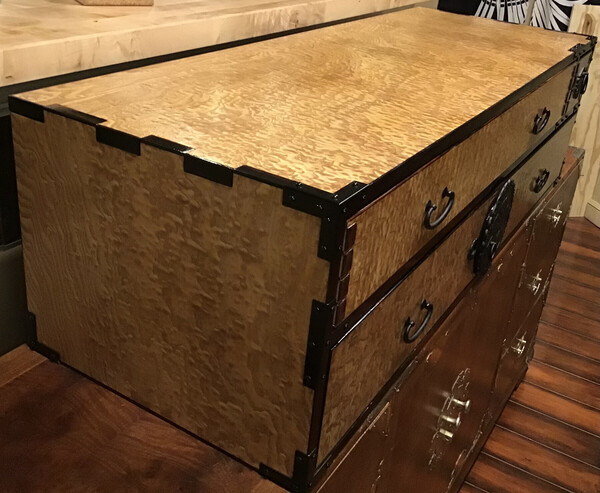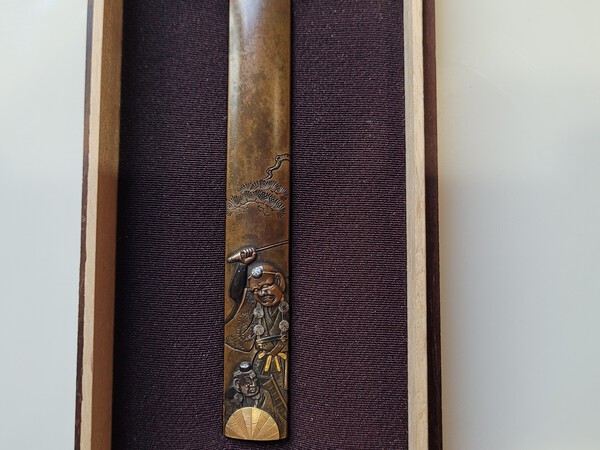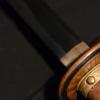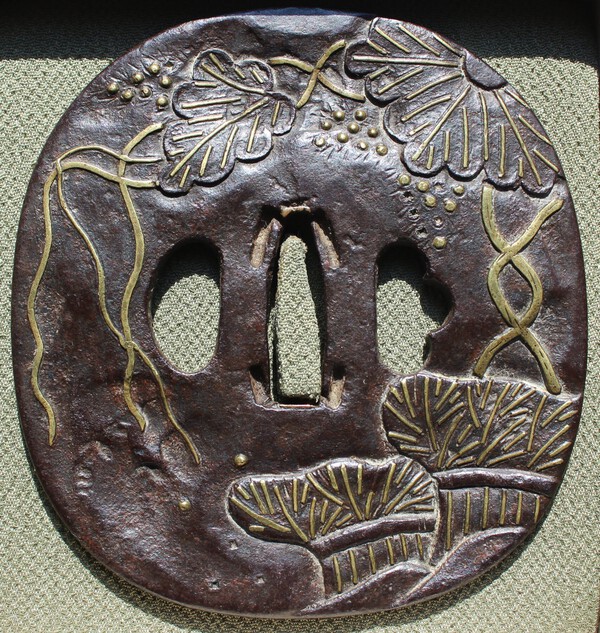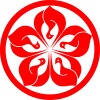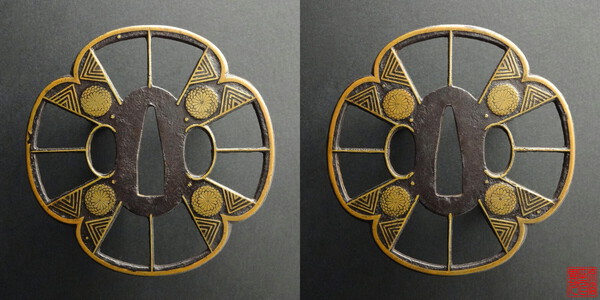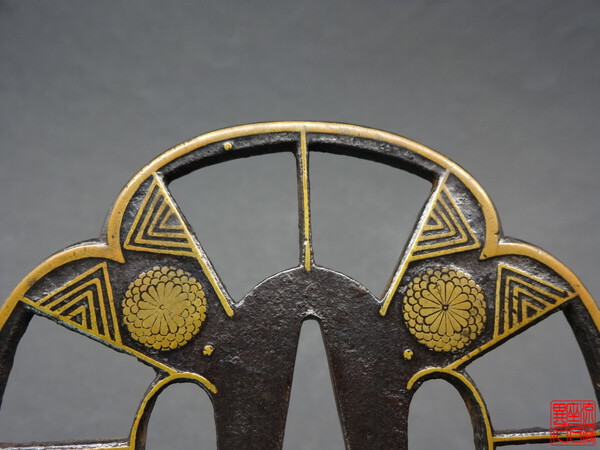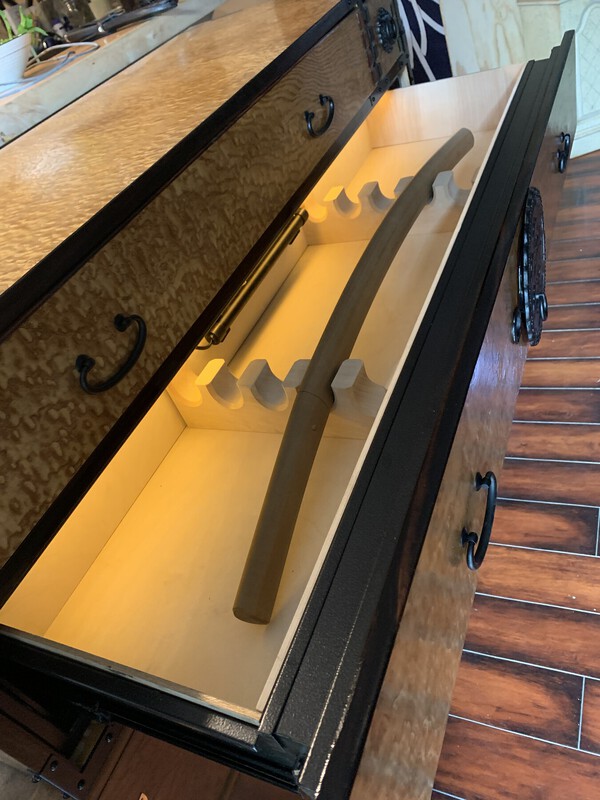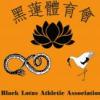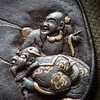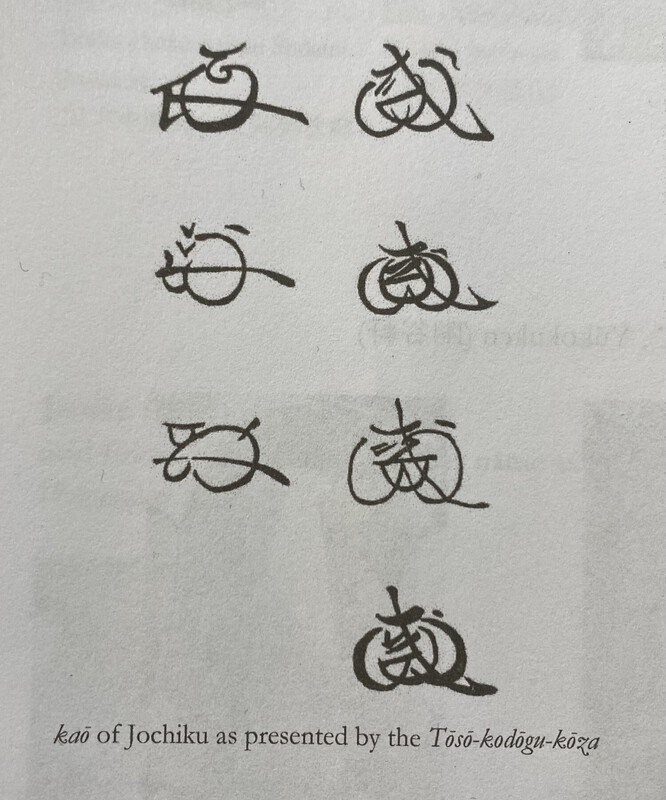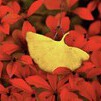Leaderboard
Popular Content
Showing content with the highest reputation on 05/31/2021 in all areas
-
10 points
-
In the case of this blade it passed within 5 years so the same people were in charge. There is some misunderstanding above of the process. If you go and submit something that has existing papers yes they can find it and yes they do check. Knowing the blade's past history is important, especially with mumei blades, as the historical attributions provide a base from which to make current and future attributions. There were a lot more available to work with 300 years ago than now. So of course you want to have supporting documentation and to consider the history, especially if it's a judge like Honami Kochu. In the case of an overturned attribution, one would HOPE that it would happen. The idea that the NBTHK is a monolithic AI that popped into existence 60 years ago fully formed with no hope or need of change is flawed. It's composed of people and those people both improve their education as time goes on and more information and history will always come out. There is another fundamental misunderstanding about papers and attributions which I've talked about before, which is sourced in some Japanese scholarship, which is as the quality degrades the judgments can slide more and more sideways lacking any distinguishing characteristics. There is a Yoshimichi thread posted here and the blade is very characteristic so there is no other possible attribution if this was mumei, only whether or not it's genuine (I think it's ok). As you slide down the quality scale and erase characteristic features (both together) it is hoping for something unrealistic, that everyone will agree and assess the blade identically on eyeballing it. So if you have junk, you will basically get attributed to junk and the point is that which junk it is becomes neither meaningful nor possible to determine. Now on the higher end of things, a blade such as this Enju in question sometimes has some additional information that isn't shown on the NBTHK paper. It can have an old origami, it can have a sayagaki by Dr. Honma, and whenever it passed for whatever reason a conservative judgment was issued. I have seen Dr. Honma's sayagaki to Awataguchi Hisakuni and the NBTHK only accepted the blade as Awataguchi and nothing more. The blade was Juyo as Awatguchi Kunimitsu. So you have some span of disagreement here being sorted out, where it was Juyo at the time Dr. Honma was in charge and only settled as Kunimitsu then "downgraded" to a school attribution. Dr. Honma presiding over both sessions. So you can sit back and wring your hands over it or understand that you have a basic disagreement and the blade was not "downgraded" by changing it to Awataguchi school. It's done only to broaden the attribution to resolve disagreements. There is a mumei tanto attributed to Shintogo Kunihiro and when the blade's old Honami papers were discovered it was changed to Awataguchi Norikuni. Both attributions are suitable but Norikuni looks stronger and once the old judgment by Honami Koon was found then it is only appropriate to modify the attribution. More information SHOULD imply going back and reassessing and changing your opinion. Only an idiot refuses to change an opinion in the face of new information or ongoing study. So by this rule, you WANT judgments to both be conservative, and to be open to re-evaluation. Going to the Enju again, Enju is a conservative judgment that can be used to settle an issue about where the blade stands between Rai, Awataguchi and Enju. If it has properties of all schools and it is top class it could fall into any. An Enju blade is not necessarily inferior to a Rai blade. We do not know the state of polish or condition or history or information on the blade at the time of Juyo. We only know that at Tokuju the NBTHK had the opportunity to say den Awataguchi, Awataguchi, or den Awataguchi XXX, or Awatguchi XXX. The span of time is 5 years. They don't have to do anything or even pass it at Tokuju if there isn't any reason for it. There are other similar cases, but as the quality goes up, the chance of this happening goes down. Nobody should be mistaking Masamune for Masahiro but people saying Shimada or Masahiro that is acceptable. Because there isn't really any span of quality difference between those two and the styles overlap. Now, Norishige, Go, Masamune and Yukimitsu can overlap. The important thing is not getting mixed up between Shimada and Masamune or Norishige and Norikuni. From the first the school is the same but the quality and period are light years apart. For the second the period is close but the styles and school are far apart. If someone wants to say Norikuni and another wants to say Shintogo, those are a lot closer and depending on polish, condition, and how conservative you are being then you go one way or another. Last note: the entire concept of papering Hozon, Tokubetsu Hozon, Juyo and Tokubetsu Juyo has built into it this concept of re-study and revision. If a blade is good enough to promote it is definitely considered open to reassessment and new opinions. If you submit it covered with rust vs. top polish then what the judge can say is going to be different. Any shade of gray in-between means you need to accept some conservatism or leeway in the judgment. But, you need to absolutely understand and accept that elevating papers is not simply rubber stamping what was handed to you. It is re-assessed. If the prior judgment was not adequate it will be open to challenge and re-attribution. As the level goes up, then the scope narrows. So this is also something to really grasp and understand. If you have a completely lights-out Enju at Juyo, YOU need to understand that you are not at the conclusion of the story and that the judges likely understood this as well. If you have a pedestrian Enju YOU need to understand that you are at the end. If you cannot tell the difference this is your shortcoming and YOU need to improve your study. Once you see what you are dealing with and understand where you are in the story, you can understand what a placeholder attribution is and why it's done and that sometimes it's done with the idea that it's definitely going to be reassessed and revised. Anyone who ever got horyu should also understand this. It's not a reason to panic its a reason to send it in again because the judges on this viewing were not ready to make an assessment. If they felt it was gimei or bad for whatever reason that's what they would say. In terms of Juyo and such as well, what is acceptable at the lower level papers is not acceptable as the level elevates, and this is because of the necessary gray areas of mumei assessment. Because you are not dealing with an absolute in the sword, completely lacking the ability to time travel, a lower level paper will have more leeway built in. So if you can get it to Tokubetsu Hozon based on its history it is maybe going to be acceptable on the balance of all available information to let it sit there as such but it can't go higher because the requirements tighten every time you go higher. So you can maybe help yourself by looking at a paper and thinking "this is the least disagreeable conclusion at this level given this amount of study in the current condition of this sword and this amount of revision of existing previous decisions and with what we know in total in terms of the item's history and the universe of current scholarship." And if you think that weird things do not happen in terms of associated articles with swords, I am a case in point as the shirasaya with sayagaki for a sword that I bought about 7 or 8 years ago appeared attached to an unrelated sword as an "extra" shirasaya at Sotheby's auction, and wasn't shown in the photos on the auction page but only happened to come up in about the sixth level of emails with the auctioneer. Stuff gets separated, and sometimes is found again. So something with Dr. Honma's sayagaki should definitely be considered in different light than one without. I would hope that someone might consider his opinion when offering theirs and if it causes them to reassess then good. Though in this case the sword is already Tokuju with the same assessment, in the case of the Hisakuni above I would hope that people might understand the blade to be OK as Hisakuni and not just Awataguchi knowing what his opinion was. That should be guidance and if the blade couldn't get that assessment in the attribution column at Tokuju, I hope people would understand as being OK and to take it "under advisement" that not everyone agreed with him and it is OK to come up with your own opinion. Edit: one thing I meant to hammer as a point is that Tokuju is the only one that is going to be considered to be impossible to revise other than for factual information (i.e. a mostly obscured character that can be reassessed later to change a date for instance). The case of that blade is a tanto that was attributed to Yukimitsu by Honami Kotoku and then polished and changed to Masamune by Honami Kochu. So you are talking about the number one and number two judges, or more like 1a and 1b. The blade was owned by Tokugawa Ieyasu and Toyotomi Hideyoshi among others. This passed Juyo as Masamune and then Tokuju as Yukimitsu mostly because of the strong feelings of Sato Kanzan that Yukimitsu should be considered at the same level as far as I can understand it. After his passing the blade was revised back to Masamune. Other than this exception which had of course strong past judgments in both directions and the most elite ownership: when something is passing Tokuju then it's done and the opinion being issued is done so with this consideration in mind. When you pass it at Tokubetsu Hozon and you think it can end up as Masamune then it could be done as Yukimitsu at this level because they know they will see it again and for a longer period of time with a spirited debate. This is the concept of a placeholder attribution, and to a lesser extent it can happen at Juyo. A case in point of this is a Tokuju Yukimitsu I once had that passed Juyo with an extraordinary note that the blade was historically Yukimitsu but that this was something to reconsider and revise at a later date (i.e. after being accepted as Juyo and this put in writing). This indicates that the earlier Juyo, the thought that the attribution could be revised and reassessed with more study and more knowledge was an active thought. The blade later passed Tokuju and Yukimitsu was confirmed but my feeling is that the blade was more likely Sadamune. Yukimitsu however is acceptable and one can consider it as such and it is OK. But understanding the context and the care of the judges and that even in writing they would say this is open to reassessment helps you understand what the intention was. In all of this, a blade should hopefully only go sideways or up when it passes through the process, if the process is working correctly. A Chogi that gets reassessed to Kanemitsu is sideways or an Aoe that gets changed to Kanemitsu is sideways to being up. But those do not indicate a randomness or an error, they indicate conservative judgments or the degree of flex that is necessary when something is based on opinions or a committee agreement. So Enju going to Awataguchi shouldn't be anything that should break a heart or cause a pulse to race. Awataguchi going to Nakajima Rai is what is the headache and a problem. So: remember... it's very difficult to undo this kind of thing. Once you say "Masamune" you can't retract that easily and then say Yukimitsu and the time it happened got overturned. You can say Yukimitsu and then retract that and say Masamune or Sadamune later which was what my blade was open to during and after Juyo and what happened to that tanto above in the first place. Tanobe sensei will indeed (and recently has) looked at blades (the case in point for recently is a member of this board but I don't want to dump anything)... but he looked at the mei and pronounced it good and that the blade should be carefully polished... and that he wants to see it again after polish. He's always going to make sure that there is something held in reserve to look at it again if the state is going to change. So in this case because it's verbal he's indicating a positive result on what he sees so far but it's subject to revision after polish. The blade needs to come back and be of a quality and style (style is probably already OK) that is in agreement with the mei before he is going to feel satisfied. I think for the owner that it is going to go 100% ok but ... this is how a good judge operates. ... Edit 2: I will throw in one other anecdote which comes from a few years back where Tanobe sensei showed me a really wonderful unpapered sword that had returned from polish and he had been studying. He said at this time that what I would say and what Ted Tenold would say is something he would consider in his appraisal. I looked at it and I offered an opinion that it was Masamune and this to me was pretty clear from the quality of the nie in it. The hamon looked like it was 40 below zero and someone breathed on it and their breath had frozen into crystals. I said if the owner wants to sell this please let me know because I would love to have it whatever it was. I then asked him what his judgment was... He told me, "I don't know, that's why I'm studying it." Of course he had this thought in his mind already about Masamune but not even verbally was he going to point in that direction because once saying that he would not be able to undo it. Again, shows the care with which this thing is done as the level goes up. Next time I encountered the blade it was in the Juyo oshigata as Masamune then passed Tokubetsu Juyo right after that confirmed as Masamune. In the end my snap judgment was fine for *kantei* and in hindsight it was a good call, but we need to remember always that kantei and attribution are two different things. The first is an exercise and a game and a chance to learn something. The second is ideally a careful process and even verbally Tanobe sensei in this case was not willing to say what he was thinking but was actively probing other people's thoughts, no matter how minor a character they were in the overall story, he wanted to hear what they thought. If something comes into Tokuju as Enju and the quality and skill and inherent features of the blade cause a reassessment to Awataguchi, I look at that as the process working not that the process is faulty. At the end of the day if you are going to buy it you need to be able to look at the blade though and in your own heart accept that the judgment is good. At the end of the day, nothing is perfect and it is still a subject matter that comes down to opinion, but hopefully educated and thoughtful opinion. There are things with papers that I don't like and other people accept without question. There are things in top collectors or with top dealers that they accept and others may throw rocks at. You need to be happy yourself with what you read and see.7 points
-
6 points
-
6 points
-
This is an extract from "Meito -or- What Makes a Masterpiece?" by Nobuo Ogasawara, Retired head conservator of the National Museum, Tokyo and is I think fundamental to understanding attributions. A lot of what he had to say to me was enlightening when I first read this and helped me understand and is interwoven with a lot of my comments that I make about quality and attributions including those above. This entire article is good but I'll just take some highlights so I don't have to type the whole thing in. .... Depending on who evaluates unsigned swords, a Masamune may be attributed to his son Sadamune, or a Kanemitsu to his pupil Tomomitsu. Differences of judgment are acceptable to a certain extent, but it is evidently wrong if one evaluates a Hizen Tadayoshi from the 17th century as Rai Kunimitsu from the Kamakura period at the end of the 14th century. Deliberately wrong judgments are a criminal matter, but even if it is not deliberate, anyone who gives an attribution to Kanemitsu when the work is by a pupil such as Tomomitsu or Hidemitsu will gradually lose all authority. [Darcy note: he first talks about a Masamune to Sadamune (i.e. conservative) ... a Kanemitsu to Tomomitsu (i.e. conservative)... the last sentence notes Tomomitsu or Hidemitsu to Kanemitsu which is then an inflated or incorrect judgement... so it is OK to issue a conservative judgment in the right ballpark but it is not OK to take an inferior work and assign it to a high level maker, this indicates an inability to understand the quality and so ends up with a loss of authority] We should consider the principles of Meito. Both masterpieces and inferior blades have always existed, and it is perhaps also not surprising if a single swordsmith may have been both successful and unsuccessful. In the course of the centuries many swords have been destroyed or lost. I think it amazing that swords have survived at all, considering their primary use as weapons, and their raw material is iron which can end up as a lump of rust. We must credit the Japanese at this point with the sense of beauty which impelled them to take such good care of their swords. ... One should not however confuse variation with failure. When Soshu Masamune makes nie-kuzure this is intentional, but if nie-kuzure appear as a result of failures of control during tempering, then the blade can never be good. ... There are also swords which do not attract us at all, even if the style is typical of its time and even if the jitetsu or hamon lack obvious flaws. For example a mass produced kazu-uchi-mono blade may just as plausibly be assigned to Bizen, Bungo Takada, Kai Mihara, Uda, or some other school, because the sword is of inferior quality. ... Having realized the qualities and attractiveness of the sword, it is natural to wish to own some. The most inconvenient thing about this, I think you will agree, is of a financial nature. If we think only about economics in this way we shall end up getting cheap swords which may easily be disposed of when necessary. This is perhaps understandable, but the true collector learns to transcend faincial limitations. We collect swords nowadays because we appreciate them as art objects. We do not collect them because of their excellence as weapons. Nevertheless the essence of the sword is its effectiveness as a weapon and its superiority as a weapon in expressed in the beauty of its sugata, in the brightness of its jihada, and the beauty of its hamon. ... As I have said, the Japanese Sword may be considered as a work of art, and an object of contemplation. By contrast, I have also said that the Japanese sword is a weapon, to which one could entrust one's life. The sword is both of these things. ... Once upon a time there was a rich merchant named Takeda Kizaemon. He was a great devotee of the Tea Ceremony., but he ran into difficulties and lost all his wealth, ending up as a groom in [the] stables. But, he retained his favorite Tea Bowl which he kept in a bag around his neck until the day he died. This bowl still exists and is called "Kizaemon Ido." When I was young, my Sensei showed me a sayagaki. The inscription said enigmatically: "Even if you were standing at the edge of the road..." He asked whether I understood it. I had to say that I did not. he explained that "to stand at the egde of the road" means you have become like a beggar. Even if the owner were to become a beggar, he would never part from this sword. The feeling for a Meito exists only inside us, and has really nothing to do with the works of famous swordsmiths or expensive swords. However, you must have the knowledge to understand and appreciate it. The sense or feeling attached to the swords is very important. This is the secret when you are collecting Meito.4 points
-
4 points
-
4 points
-
4 points
-
3 points
-
Hi, A recent addition, and what I think combines Saotome/Tembo and Heianjo schools? Height 93mm Width 87mm Mimi thk 3.5mm - 4.5mm The design is of ten zogan dots and linear brass zogan, vine leaves, tendrils and grapes. The bottom right on the front face looks like some crops bound together? The plate looks Saotome /Tembo with a rough hammered surface and a few hot stamps, I can't identify which one? The inlay work looks Heianjo. I'd appreciate any thoughts on this one please. A few images below, one taken in sun light. Thanks Colin2 points
-
James, there is a "brother blade" of nearly identical shape which is in Juyo #18, Darcy posted it in this thread here: However, this one doesn't have a cutting test. I've asked for cutting test marked Masayuki/Kiyomaro blades a page earlier and came to a total of three others known with a cutting test, hence with mine there would then be a total of four known. Markus additionally yesterday was so kind as to count the Juyo blades by Masayuki/Kiyomaro and came with the number of 72. Assuming Yas a page earlier in post #177 is correct with his "around 130 blades" for this smith, this puts the Juyo rate at 55,3%. This is not knowing how many of the non-Juyo blades by Masayuki/Kiyomaro were submitted to Juyo and failed. I don't know how this "Juyo rate" compares to other smiths and if such a comparison may at all be done though. I can't add anything on the value, except that I'll some day need one for the insurance when it is back. But the ROI rate doesn't matter this much anyway since I'll be keeping it, this has not changed since the starting post. It might not be usual to start a Nihonto collection with a Masayuki, but I don't think it is wrong either.2 points
-
2 points
-
Matt, 2:00 pm here now, i.e. 10 hours to go until Japan midnight. 1. Please contact Brian as to how you would like to pay. 2. When Brian contacts me, I will then ask the winner for their forwarding address etc. (You?) Fair warning... PS On Saturday I had a letter from the USA, which took ten days to get here. So the mail does seem to be moving...2 points
-
2 points
-
2 points
-
Dear All This is one of my most recent acquisitions. It is a nice mokko gata iron tsuba with brass inlay. Dimensions 86.3 mm x 85.5 mm, 3.8 mm thick at seppa dai. The brass inlay is almost the same on the omote and ura sides. The only difference is in the positioning of the ten-zogan away from the seppa dai. My first idea was of course Heianjo, but the practically symmetrical design between front and back leave me with some measure of doubt. Any of you have a different attribution? Aside of the four kiku mon (菊文) the chevron like decorations are a little puzzling in their meaning. If I do a search on Jisho (https://jisho.org/search/chevron) I get as a result "Yamagata" (山形) i.e. "mountain shape; chevron; cone". Is this a fitting description for the triangular shapes surrounding the chrysanthemums? I am missing something? Do you have/see a different interpretation? Or the combined design chrysanthemum-chevron have a meaning by itself? Your comments are greatly appreciated. Best Regards Luca1 point
-
Also from me a big thank for this excellent work. Great information and now I know more about the Masakuni sword (page 14) :-) Thank you!1 point
-
1 point
-
1 point
-
Not hell at all—I don’t have any veneer bags, or an air pump or anything. I just cut the veneer, taped it to some MDF and rolled heat-activated veneer glue on both it and the plywood substrate. After a few hours, a second coat to each. The glue dries to a firm, plastic-y consistency. Then you mate the pieces and iron them with a clothes iron. https://www.veneersupplies.com/products/Better-Bond-Heat-Lock-Veneer-Glue.html Cost of entry is so low that if you have any interest at all in veneering, there’s no reason not to get a bottle of heat-activated glue (and a roller, and a veneer saw) and give it a go...1 point
-
1 point
-
I'm guessing Nara San Saku. Initial reaction was to go with a Hamano student, but there is something maybe earlier about the Pine Needle rendering that feels Shozui or earlier? That is my best guess in 30 seconds. So, Big J. -What does the back say?1 point
-
No probs, Matt, take your time and take it away! Thank you, all of you, for volunteering to uphold this valuable site. PS I was owing Brian one for all he has done for me here. Sssshhh... Many thanks!1 point
-
I'm in the field right now, I'll be home in 3 - 4 hours to transfer everything!1 point
-
STOP the auction START a new process of transfer to new owner...1 point
-
1 point
-
I especially like the idea of the gun safe being the internals. From where did you get the metal fittings? John1 point
-
That's damn impressive, Richard! Well thought out & designed. Just remember that thieves who see your locking machanism can just walk away with the entire katanadansu. Bolt to something solid.1 point
-
Inspired now. Going to see if I can draft up plans for something similar. Working on a non-Nihonto display coffee table currently and it it turns out half decent, may look at this idea.1 point
-
I think you should write the combination here in this thread, just in case you forget it of course!1 point
-
1 point
-
Yes indeed! Quite a piece of furniture, it will add to the pleasure you get from viewing swords every time. All the best.1 point
-
This is very impressive, kudos. I can imagine your joy building such a beauty. Definitely something to be proud of !1 point
-
That is absolutely beautiful, the joinery is superb. If you were to make a business out of these you would never be out of work......1 point
-
1 point
-
1 point
-
1 point
-
Dear Bob, first of all let me say congratulations on the first 50! You have been as regular as clockwork in supplying us with beautiful eye candy every few days for quite a while. I'm sure that all the other NMB members are enjoying seeing your beautiful collection unfold and are looking forward to another 167!!! As for Item 51, it appears that it is a “Tadashige” that Haynes did not have in his original Index, but he added it in his second supplement (Haynes #09149.A). His addition is probably based on your tsuba (see Haynes’ text below where it appears to describe your exact tsuba from a Bonhams Auction). I double checked the dozen or so other Tadashige in his Index and none of the others matched, so I think that Haynes was correct to list this as a “new” Tadashige. In his writeup, Haynes says that [your] tsuba is done with “Murakami Jochiku Haynes #02100.0”, but when I checked that Jochiku, the mei and the kakihan do not match (see the Jochiku mei and kakihan from Wakayama & Sesko below). There is only one other Jochiku in Haynes with your kanji, but his dates don’t match (1865-75). Therefore, it may be a third Jochiku not included in Haynes. In the entry for Jochiku (H#02100.0), Haynes talks about a possible second generation Jochiku (not in Haynes’ Index), but says that there is only very thin evidence for that second generation (perhaps found in the Kokubo, Furukawa, & Mosle references - which could be checked to see if the mei / kakihan match yours).1 point
-
my thought is ===== lower ranked smiths sometimes had a great day and made a great sword, and sometimes a high ranked smith made something that with a few polishes showed some issues. Personally i prefer a well made sword by a lower ranked smith, some of my favorites are Chu-Saku or ChuJo- Saku, but from a marketing standpoint the higher ranked smiths will always bring higher prices. Fujishiro-sensei had the opportunity to see many swords by a maker so he is ranking the whole of a smiths work, not an individual sword. Also being Japanese there are other factors that go into a ranking, like how the smith was thought of in the past, how famous he was or how well known, also some smiths benefited from sponsorship of powerful people and that helps. Sort of like the NBTHK today, you can have a masterpiece but if the maker has never had a sword pass Juyo that sword won't, at least it won't if i own it, if you are an important person you might have a chance of setting a precedent but not me. John, did you see the display in Chicago? The tachi with the horimono is one of my favorites and about perfect in every way but it won't pass Juyo (it is YuShu-saku) Darcy puts it better than i can, check https://yuhindo.com/ratings.html1 point
-
1 point
-
Just stumbled upon this PDF: this is the same sword, right ? Edit: no, it's not the same sword, the number of mekugi-ana doesn't match.1 point
-
Spent Friday afternoon wrapping this Wakizashi to send off to NBTHK Shinsa in Tokyo. My Sensei commented, "It will be interesting to see if they narrow it further to a particular generation." I gave him my best 'I doubt it' look. The NBTHK motto seems to be: Less is More. In the box I have also included 2. a Bizen Sukekane Tanto of Meiji 2, and 3. a Suo Province Nio Hirokiyo Wakizashi of around 1470 perhaps. Roll on... October... ?1 point
-
Onin tsuba. ie. a grade or two above Heianjo. It looks to me one of the thicker later sukashi ones of the 1500s. For similar, see the Compton Onin that sold off Andy Quirt's site: [hmmm... image seems to be gone now. I guess you have to pop open Vol 2 of the Compton Auctions. It was a very nice piece. Andy has 2 other nice ones up.] Torigoye-Haynes publication by the Northern California Tokenkai has a very good multi page discussion of Onin.1 point
-
Tom, it is going to Juyo Shinsa, but needed to pass Tokubetsu Hozon first.1 point
-
What is also very interesting is that NBTHK has provided quite accurate dating on the sword in paper even though it is not dated. In the brackets there is (天保十年頃) so they would seem to note it was made around 1839.1 point
-
There is no correct use of Uchiko unless you're a professional polisher. Full stop. There is only an outdated tradition which is causing lasting damage to blades and creating a need for re-polishing to correct the mess and damage these ancient treasures. It's a destructive practice. Play with it on rustbuckets, sure. Use it on your monosteel cutter, that's fine - but don't touch an ancient and venerable blade with that stuff.1 point
-
I am confused... I always thought a traditionally trained polisher works to restore the blade ‘as it should be’ for the smith/school and that it is returned to the owner in the condition the polisher intended? I find it difficult to believe I could ‘improve’ anything someone with all that experience and training had already done? If the polish requires more work to make ‘better’ or ‘more perfect’, then to what quality/standard is the polisher working toward? I thought we were having blades polished to bring out everything that can/should be seen? Are we saying the polisher isn’t capable of that... but somehow I am? I’m not being argumentative... just confused about this.1 point
-
If your swords has ANY pits or open grain, uchiko will cause those streaks that ruin the polish. Especially with low grade uchiko and the wrong technique and pressure. It's just not worth it on in-polish swords. On rusted and completely out of polish swords...I say go for it. It will bring out an invisible hamon a little bit.1 point
-
I have seen many scratches made by uchiko. Microfiber cloth is the way to remove oil from all polishes.1 point
-
Gary, An interesting little puzzle. The zaboshi are very much an indication that it is a helmet made in the province of Kaga. Orikasa Sensei spent a considerable length of time researching the archives in Kanezawa library and produced a list of all the armourers who worked for the Maeda family whose fief it was. He found that the Maeda, who were granted the province by Toyotomi Hideyoshi in 1583, only employed Haruta armourers until 1800 when the first Myochin was taken on. Sasama, in his Shin Katchushi Meikan lists 4 armourers who signed Iehisa, One of whom was a member of the Saotome group, two who were of the Haruta, the remaining one being a Myochin. The latter is listed as working in Yukinoshita in Sagami province around the Tenbun era, not Kaga, but Sasama adds that there is no extant piece bearing the name and doubts his existance. One final point is that the kanji Ie- is not at all usual among Myochin smiths, by far the majority using Mune- . Having said that, I have a helmet by a Myochin Ietsugu who was a Soshu smith. I haven't the list of Kaga armour makers to hand at the moment, they are on another computer. I will try and remember to look tomorrow. Ian Bottomley1 point



